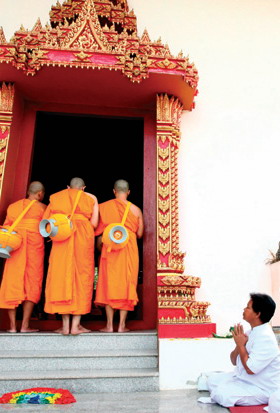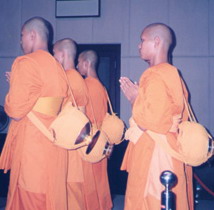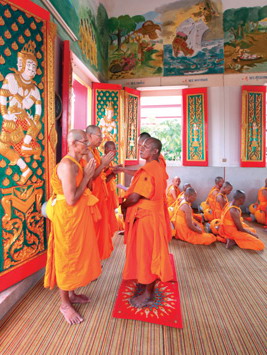Ordination Traditions during the Time of the 'Buddha

In the early Buddhists era, all of Lord Buddha's disciples were monks, without any novices, when young Prince Siddhattha was ordained, his ordination was referred to as "lower ordination" (pabbajja), a term which nowadays is used to refer to novices who were ordained. However, he was already too old to be considered a novice. From the time Lord Buddha allowed novices to be ordained, the ordination of monks became known as higher ordination or {upasampada).
[read more click button below]
The very first novice ordained during the time of Lord Buddha, was his son Rahula. He was ordained when Buddha returned to his hometown of Kapilavatthu, to give a sermon to his parents and relatives. The reason Rahula became a novice was due to his mother's encouragement for him to seek out Buddha, and asked him for his inheritance and throne, over which Lord Buddha could still lay claim despite his being a monk.Lord Buddha felt that his son deserved more than mere worldly riches, and that his son deserved true happiness, which was worth more than all the world's riches. Lord Buddha asked Sariputta, a disciple, to ordain Rahula as a novice according to the ritual of" Taking the Three Refuges" Ever since then, Taking Refuge has remained the standard by which all novices are ordained, even to this day.
The process of ordaining novices according by "Taking Refuge" entails the following: Novices must have their heads and moustache shaved and don saffron robes. After that, they must pay respect to their preceptor, in order to seek permission to be ordained as a novice. The preceptor then leads the novice in a chanting ceremony to remind the novice of the Triple Gem. The novice must then respond with his own chant taking refuge in the Triple Gem. As follows.
I take refuge in Lord Buddha
I take refuge in the Teaching
I take refuge in the Monastic Order
For a second time I take refuge in Lord Buddha
For a second time I take refuge in the Teaching
For a second time I take refuge in the Monastic Order
For a third time I take refuge in Lord Buddha
For a third time I take refuge in the Teaching
For a third time I take refuge in the Monastic Order

The reason for the three repetitions is due to the fact that sometimes, we say things without paying careful attention to our own words. The purpose of these repetitions is to ensure that the novice fully understands what he is saying. Following the chanting, for the novice to become fully ordained, he must then take the Ten Precepts, which are:
1. Abstaining from killing
2. Abstaining from stealing
3. Abstaining from sexual behavior
4. Abstaining from lying speech
5. Abstaining from consuming substances which cloud the mind
6. Abstaining from eating meals after midday
7. Abstaining from singing and dancing and other activities that may lead you to temptation
8. Abstaining from immodest dressing and appearance
9. Abstaining from indolent sleeping habits
10. Abstaining from accepting gifts or money for personal gain
Even though the novices'ordination entails only " Taking Refuge," the ten precepts serve as important guidelines for personal conduct. Should any novice break any of these precepts, especially the first five, then the novicehood will then be taken away from him, and he will no longer be entitled to novicehood.
The act of ordaining has been in existence since the very beginning of the Buddhist era. Shortly after reaching enlightenment, Lord Buddha ordained his disciples himself. This act was called 'ebi-bbikkbu' higher ordination'- Lord Buddha declared:
"Become a monk, for the Dhamma is good. We must cleanse ourselves so that we may be free from all worldly suffering"
The first monk ordained by the Buddha personally, was Kondanna. He was the first of Lord Buddha's disciples, and Buddhism's first monk. He was ordained following Lord Buddha's first Sermon entitled the Dhammacakkapavattana Sutta given in a deer forest known as Isipatana. The Buddha's sermon brought upon Kondanna a revelation, and allowed him to see the light of the Dhamma, thus allowing him to become a Stream-enterer, or holy one.
Later on, Lord Buddha gave permission to monks' ordination using " Taking Refuge," which is based on the same ceremony for novices-the difference being the number of precepts that Monks must abide by. In time, this process became known as 'ordination by chanting of a motion', which is used to this present day.
Ordination Procedures for Novices and Bhikkhus
There are two types of ordination, the first is those who are ordained while not yet twenty years of age, the second being the beginning stages of those who take higher ordination.
Higher ordination is the act of ordaining monks in Buddhism. This process involves ten steps.
1. The individual must first be ordained as a novice.
2. The ๒dividual must request dependence from the Preceptor
3. Paying respects to the Preceptor
4. The Preceptor tells him his own name and the novices in Pali
5. The Preceptor presents the novice with his alms bowl and saffron robes
6. The Preceptor then requests the novice to retire to a point outside the assembly hall
7. Appointed monks assemble outside the assembly to ask the novice examination questions (antarayikadhamma)
8. Ask the novices to reenter the assembly hall after the exam
9. The novice must then request permission to be ordained
10. The novice must then be asked examination questions again in the assembly hall
Qualifications for those to be Ordained
Those who wish to be ordained as a monk must be at least 20 years of age.

The persons forbidden from being ordained are:
First, those fall under the following categories:
1. Those who are homosexuals
2. Those who are hermaphrodites
Second, those who have done wrong against Buddhism:
1. Those who have killed an arahant.
2. Those who have harmed or assaulted nuns
3. Those who have been falsely ordained before
4. Those who have been ordained previously, but have since changed religions, and now wish to be ordained aga in.
5. Those who have been ordained previously, but have broken the ten precepts, and were asked to leave monkhood.
6. Those who have caused schism in the monastic community
7. Those who have caused harmed a Buddha
Third, those who have killed their parents or guardians.
Those who fall into any of these categories are unworthy of ordination and strictly forbidden from going forth into the monkhood.
Those who are not eligible, but not forbidden from being ordained
Although not expressly forbidden from being ordained, those who fall under the following categories are not deemed recom-mendable. However, if they are already ordained, it does not mean that they must disrobe if they suffer from these handicaps:
1. Those who suffer from the following diseases
a. Leprosy
b. Measles or Pox - related illness
c. Fungus of the skin
d. Throat and lung disease
2. Those whose limbs are missing
3. Those who suffer from skeletal deformity
4. Those who are handicapped, blind, or deaf
7. Those who have outstanding debts
8. Those who have been convicted of a crime.
9. Those who are notorious for wrongdoings and mis deeds.
Those who are eligible though may not yet be ready to be ordained.
Those who may not yet be ready to be ordained, but are eligible, and not forbidden from doing so, are as follows:
1. Those who lack a preceptor
2. Those who do not have an alms bowl
3. Those who do not have saffron robes
4. Those who do not have both of the previous items
5. Those who borrow an alms bowl
6. Those who borrow saffron robes
7. Those who borrow both of the previous items



